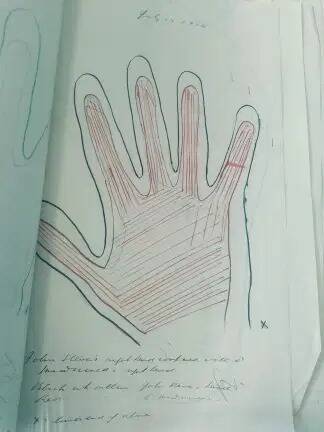
Maud was obviously too young to understand what happened to her Daddy but I reckon she would have been old enough to understand that her Daddy had disappeared. In this photo I would say Maud is maybe aged 6 or 7 and she doesn’t look very happy. (Actually when I review our surviving photos of Maud, she only actually looks happy after she married, perhaps her family life without her Daddy was so hard and her family suffered so badly). Maud lived until 1995 and is still remembered as a true matriarch of our family.
Finally, I have been racking my brain as to where John was buried. His wife and her children and grandchildren emigrated from Belfast to Glasgow in 1925 and John is therefore not buried with his wife in Tollcross cemetery, Glasgow or with his daughter Maud in St Kentigern’s cemetery, Glasgow. I also discovered that John was not buried in the cemetery at Hartwood asylum indicating that his body had been ‘claimed’ by his family.
I then wondered if his mother and siblings in Rutherglen might have buried John in Rutherglen. I e-mailed the Bereavement Services department at South Lanarkshire council and they confirmed that John was indeed buried in Rutherglen cemetery with his parents and brother.
Thank you to Jacqueline Hunter for the research and information
I have been chatting online with a lady who has researched her family history and discovered that at least nine of her ancestors were admitted to various asylums across Scotland, including Hartwood.
So, why were they placed in asylums?
The truth is unsettling but, in the early 1900s, such cases were considered entirely normal grounds for institutionalisation. Many suffered from hormonal disorders that caused them to expose their sexual organs. There were also multiple instances of violence or threats of violence, delusions and hallucinations, crawling on all fours, being admitted from prison under charges of malicious mischief, or even attempting to jump from a tenement window three storeys high in a desperate bid to escape their personal demons.
Below are some extracts from Jacqueline Hunter’s blog about her family:
JOHN STEVENS
John was my great-great-grandfather. He was born in 1861 in Ettrick, Selkirkshire, to John Stevens and Elizabeth Tullie and married Elizabeth Gamble in Ballymoney in 1895.
The General Register of Lunatics in Asylums tells me that John was admitted as a pauper (i.e., under the Poor Law system) to Hartwood Asylum, Shotts, where he stayed for 12 months until his death in February 1905. He died from acromegaly (a hormonal disorder causing abnormal bone growth) and acute endocarditis (a heart infection).
What really struck me was the change in John’s mental state before and after his admission. It seems that John was aware he was unwell while living with his wife and then his mother, but neither could manage his condition. Once admitted to the asylum, he was cared for by people who understood how to help him.
John’s condition before admission:
-
He lay in bed, dull and apathetic, refusing to get up.
-
He claimed to have worked for Robinson and Charon in New York (though he was actually employed by the firm in Belfast).
-
He repeatedly said "it is down," referring to his rupture (hernia), insisting it was not ruptured and that his testicles were “down.”
-
His mother reported that he wanted a doctor, wore a new tie for him, exposed himself indecently in the house, and was sometimes afraid to sit down for fear of injuring his testicle.
-
His brother James said John blamed their mother for causing the rupture and threatened to strike her, and that John wandered around the house with his trousers down.
-
He was significantly demented, with poor memory, irritability, incoherent speech, and unable to give a rational account of his actions.
-
James also said John was very depressed and sometimes became excited and violent. He was guilty of indecent exposure.
I was relieved to learn that just one month after admission, John’s medical problems were properly investigated and a diagnosis made:
29 March 1904:
The patient has a dull, heavy complexion. He is considerably demented, childish, and incoherent in speech, with severely impaired memory. He shows great enlargement of the nose and facial bones and very large hands. His appearance is consistent with acromegaly (a disorder caused by excess growth hormone).
Fascinatingly, John’s doctors compared the size of his hands and feet to those of a “normal” person. The tracings of his hands and feet still survive, allowing me, his great-great-granddaughter, to see and touch them. (John’s hand is shown in the black outline.)

